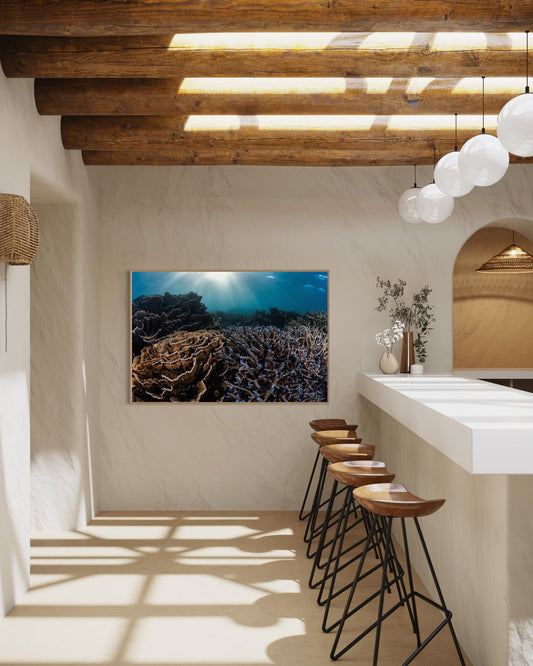-
The Creator
Vendor:Jake WiltonRegular price From $110.00Regular priceUnit price per -
The Corals
Vendor:Jake WiltonRegular price From $110.00Regular priceUnit price per
Why We Must Protect Coral Reefs
Coral reefs are often called the “rainforests of the sea,” and for good reason. These vibrant underwater ecosystems support an astonishing diversity of marine life, protect coastal communities, and play a crucial role in maintaining the balance of our oceans. But today, they are under severe threat due to climate change, pollution, and destructive human activities. Protecting coral reefs isn’t just about saving marine species—it’s about safeguarding the health of our entire planet.
What Are Corals?
Corals may look like rocks or plants, but they are actually tiny marine animals called polyps. These polyps live in colonies and secrete calcium carbonate, which forms the hard, protective skeleton that builds coral reefs. Corals come in two main types:
-
Hard Corals: The reef-builders, responsible for creating the vast structures that provide habitats for marine life.
-
Soft Corals: Flexible, tree-like corals that sway with ocean currents, adding diversity and beauty to reef ecosystems.
The Importance of Coral Reefs
Coral reefs are some of the most valuable ecosystems on Earth, providing benefits that extend far beyond the ocean:
-
Home to Marine Life: Coral reefs support 25% of all marine species, including fish, sea turtles, and sharks.
-
Coastal Protection: Reefs act as natural barriers, reducing wave energy and protecting coastal communities from storms and erosion.
-
Oxygen Production: Corals contribute to the ocean’s role as a major producer of the oxygen we breathe.
-
Food & Livelihoods: Millions of people worldwide rely on coral reefs for fishing, tourism, and economic stability.
-
Medical Discoveries: Coral organisms have led to groundbreaking medical advances, including cancer treatments and pain relievers.
Human and Coral Interactions
Corals have long been a source of inspiration, sustenance, and economic opportunity for coastal communities. However, human activities have also contributed to their decline.
-
Tourism & Recreation: Snorkeling and diving provide eco-tourism opportunities, but irresponsible tourism can lead to reef damage.
-
Fishing Practices: Sustainable fishing is essential, as overfishing disrupts reef ecosystems and destroys coral habitats.
-
Cultural Significance: Many indigenous cultures view coral reefs as sacred and essential to their way of life.
Threats to Coral Reefs
Despite their resilience, coral reefs are in serious danger. Some of the biggest threats include:
-
Coral Bleaching: Rising ocean temperatures cause corals to expel the algae that give them color and nutrients, leading to mass die-offs.
See article on Bleached Anemones.
-
Ocean Acidification: Increased CO₂ levels make it harder for corals to build their protective skeletons.
-
Pollution: Runoff from agriculture, plastics, and chemicals suffocates reefs and disrupts marine ecosystems.
-
Destructive Fishing: Practices like blast fishing and cyanide fishing destroy coral structures and marine habitats.
Conservation Efforts: How We Can Save Coral Reefs
All hope is not lost—scientists, conservationists, and communities worldwide are working to restore and protect coral reefs through:
-
Coral Restoration Projects: Organizations are planting coral nurseries and reintroducing resilient coral species to damaged reefs.
-
Marine Protected Areas: Establishing no-fishing zones allows coral reefs to recover and marine life to thrive.
-
Sustainable Tourism: Responsible diving and snorkeling practices help minimize human impact on fragile reefs.
-
Reducing Carbon Emissions: Tackling climate change by reducing CO₂ levels is essential for reef survival.
-
Local Community Engagement: Educating and involving local communities in conservation efforts ensures long-term protection.
Fun Facts About Coral Reefs
-
Corals are closely related to jellyfish and anemones—they use tiny tentacles to catch food!
-
The Great Barrier Reef is the largest living structure on Earth, visible even from space.
-
Some corals can live for thousands of years, making them one of the oldest living organisms.
-
Corals glow in the dark! Many species produce fluorescent proteins that create stunning neon colors.
-
A single reef can support over 1,500 species of fish and countless other marine creatures.
How You Can Help Protect Corals
Coral reefs need our help now more than ever. Here’s what you can do to make a difference:
-
Reduce plastic waste and avoid single-use plastics.
-
Choose reef-safe sunscreen that doesn’t contain harmful chemicals.
-
Support sustainable seafood choices.
-
Reduce your carbon footprint by conserving energy and using eco-friendly transportation.
-
Donate to or volunteer with coral conservation organizations.
A Future for Our Reefs
Coral reefs are not just stunning underwater landscapes—they are the foundation of marine life and an essential part of our planet’s health. Protecting them means protecting biodiversity, coastal communities, and future generations.
By choosing conservation-focused art, like GeoChange’s Coral Collection, you’re not just celebrating their beauty—you’re actively contributing to their survival. Together, we can ensure that these vibrant ecosystems continue to thrive for years to come.
-
The Creator
Vendor:Jake WiltonRegular price From $110.00Regular priceUnit price per -
The Corals
Vendor:Jake WiltonRegular price From $110.00Regular priceUnit price per






